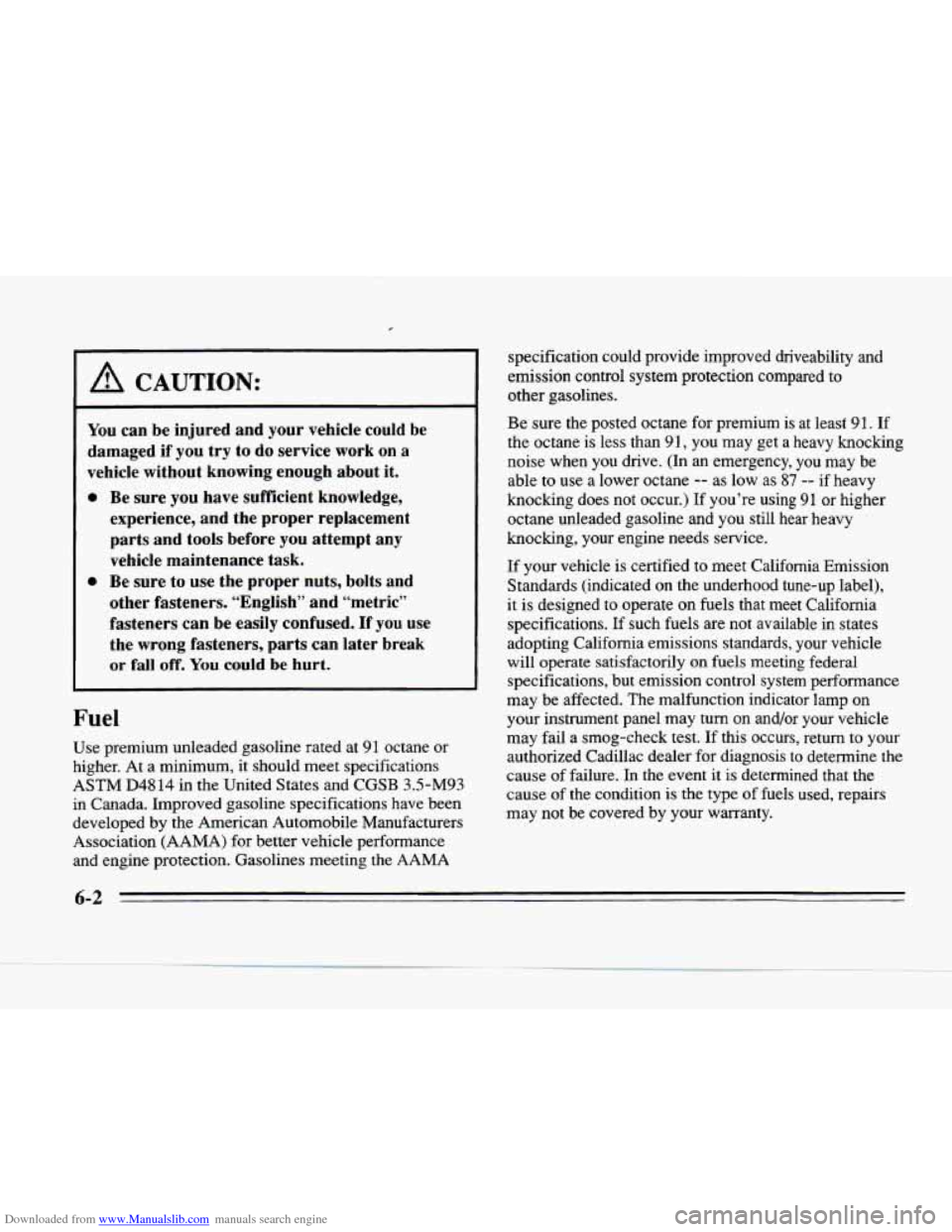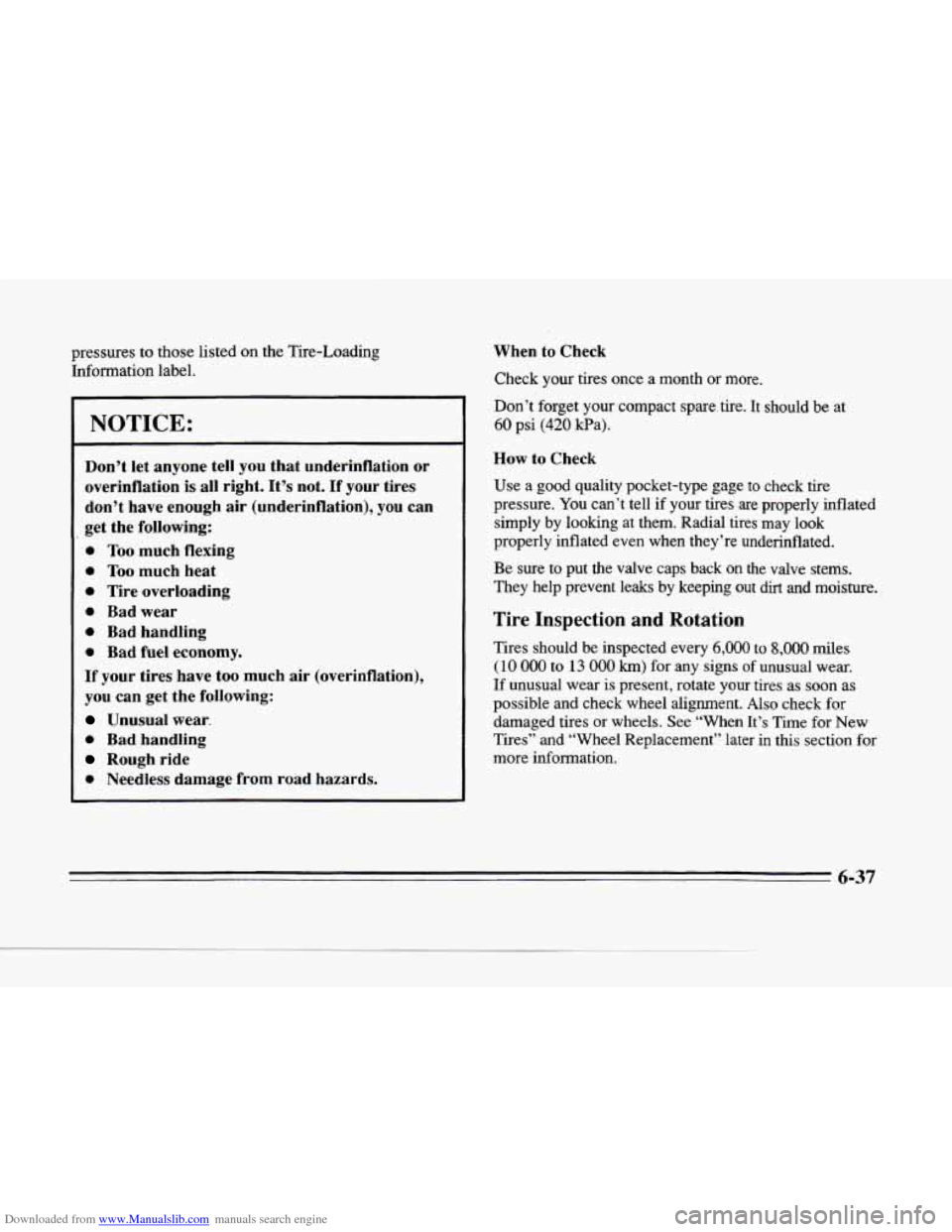Page 261 of 354

Downloaded from www.Manualslib.com manuals search engine ,
I--- ~
I A CAUTION:
You can be injured and your vehicle could be
damaged if you try to do service work on a
vehicle without knowing enough about it.
~ 0 Be sure you have sufficient knowledge,
experience, and the proper replacement
parts and tools before
you attempt any
vehicle maintenance task.
0 Be sure to use the proper nuts, bolts and
other fasteners. “English” and “metric”
fasteners can be easily confused. If you
use
the wrong fasteners, parts can later break
or fall off. You could be hurt.
Fuel
Use premium unleaded gasoline rated at 91 octane or
higher. At a minimum,
it should meet specifications
ASTM D4814 in the United States and CGSB 3.5-M93
in Canada. Improved gasoline specifications have been
developed by the American Automobile Manufacturers
Association (AAMA) for better vehicle performance
and engine protection. Gasolines meeting the AAMA
specification could provide improved driveability and
emission control system protection compared to
other gasolines.
Be sure the posted octane for premium is at leasf
9 1. If
the octane is less than 91, you may get a heavy knocking
noise when you drive. (In an emergency, you may be
able to use
a lower octane -- as low as 87 -- if heavy
knocking does not occur.) If you’re
using 91 or higher
octane unleaded gasoline and you still hear heavy
knocking, your engine needs service.
If your vehicle is certified to meet California Emission
Standards (indicated on the underhood tune-up label),
it is designed to operate on fuels that meet California
specifications. If such fuels are not available
in states
adopting California emissions standards, your vehicle
will operate satisfactorily
on fuels meeting federal
specifications, but emission control system performance
may be affected. The malfunction indicator lamp on
your instrument panel may turn on and/or your vehicle
may fail a smog-check
test. If this occurs, return to your
authorized Cadillac dealer for diagnosis to determine the
cause of failure. In the event it
is determined that the
cause
of the condition is the type of fuels used, repairs
may not be covered by your warranty.
6-2
Page 265 of 354
Downloaded from www.Manualslib.com manuals search engine When you put the cap back on, turn it to the right until
you hear at least three clicks. Make sure you fully install
the
cap.
I NOTICE:
If you need a new cap, be sure to get the right
type. Your dealer can get one for you. If you get
the wrong type, it may not fit
or have proper
venting, and your fuel tank and emissions system
might be damaged.
Checking Things Under the Hood
A CAUTION:
..
An electric fan under the hood can start up and
injure you even when the engine
is not running.
Keep hands, clothing and tools away from any
underhood electric fan.
A CAUTION:
Things that burn can get on hot engine parts and
start
a fire. These include liquids like gasoline,
oil, coolant, brake fluid, windshield washer and
other fluids,
and plastic or rubber. You or others
could be burned.
Be careful not to drop or spill
things that will
burn onto a hot engine.
6-6
Page 296 of 354

Downloaded from www.Manualslib.com manuals search engine c
rc
pressures to those listed on the Tire-Loading
Information label.
NOTICE:
Don’t let anyone tell you that underinflation or
overinflation
is all right. It’s not. If your tires
don’t have enough
air (underinflation), you can
get the following:
0 Too much flexing
0 Too much heat
0 Tire overloading
0 Bad wear
0 Bad handling
0 Bad fuel economy.
If your tires have too much air (overinflation),
you can get the following:
Unusual wear.
0 Bad handling
Rough ride
0 Needless damage from road hazards. When to
Check
Check
your tires once a month or more.
Don’t forget your compact spare.
tire. It should be at
60 psi (420 kPa).
How
to Check
Use a mod quality pocket-type gage to check tire
pressure. You can’t tell if your tires are properly inflated
simply by looking at them. Radial tires may look
properly inflated even when they’re underinflated.
Be sure to put the valve caps back
on the valve stems.
They help prevent leaks by keeping out dirt
and moisture.
Tire Inspection and Rotation
Tires should be inspected every 6,000 to 8,000 miles
( 10 000 to 13 000 km) for any signs of unusual wear.
If unusual wear is present, rotate your tires as soon as
possible and check wheel alignment. Also check for
damaged tires or wheels. See
“When It’s Time for New
Tires” and “Wheel Replacement” later
in this section for
more information.
6-37
Page 324 of 354
Downloaded from www.Manualslib.com manuals search engine c
LI
Normal Maintenance Replacement Parts
Air Filter Element .............
Fuel Filter Element ............
AC Type A1096C
25096932
AC Type GF-580 25121468
Engine Oil Filter
................ AC Type PF-58
25014377
PCV Valve
.................. AC Type CV-774C
06487779
Spark
Plugs ................... AC Type 4 1-900
5614236
Thermostat
.................... AC Type 13 1-66
3531407
Air Conditioning Refrigerants
Not all air conditioning refrigerants are the same.
If the air conditioning system in your vehicle needs
refrigerant, be sure the proper refrigerant
is used.
If you’re not sure, ask your Cadillac dealer.
Windshield Wiper Blade
(Pin Type)
.................. .22 inches (56.5 cm)
6-65